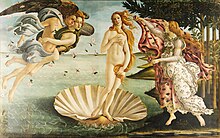Aphrodite emerging from the sea
and in a panic, she submerges.
For Mount Olympus had been seized by the IRS
it happened so fast, none of the twelve gods were able to guess.
Zeus the ruler of Mount Olympus, sky, and thunder god,
accused as well as the other eleven gods and goddesses of fraud
because they concealed from the tax office data
and now all the gods had to pay everyone pro rata..
In Athens after its defeat in the Peloponnesian War in 404 BC,
the Thirty Tyrants, an oligarchy installed in Athens by a Spartan decree
they taxed hard all citizens, rich and poor, even the gods,
and this, with much vindictiveness and malevolence Sparta applauds..
__________
The above nightmare tormented me last night
because earlier, a letter from IRS
[threatened me with plight
and they will come after me if I don't pay!!!
What a coincidence ! I was watching the same play
in the national theater of our history, like that day,
where Aphrodite left panic from a world with shades of gray*
A Rap Opera or Hip Hopera
Story Script scene-by-scene
____________________________________________ by Odysseus Heavilayias
Language adjustments and text adaptation Kellene G Safis
Digital adaptation and text editing Cathy Rapakoulia Mataraga
____________________________________________________
. According to Athenaeus, the idea of Aphrodite rising from the sea was inspired by the courtesan Phryne, who, during the time of the festivals of the Eleusinia and Poseidonia, often swam nude in the sea. A scallop shell, often found in Venus Anadyomenes, is a symbol of the female vulva.
 |
| The Birth of Venus by Sandro Botticelli |
 |
| Venus Anadyomene, by Titian, ca. 1520 (Scottish National Gallery). |
* Venus Anadyomene, (from Greek, "Venus Rising From the Sea") is one of the iconic representations of Aphrodite, made famous in a much-admired painting by Apelles, now lost, but described in Pliny's Natural History, with the anecdote that the great Apelles employed Campaspe, a mistress of Alexander the Great, for his model.
* The Thirty Tyrants (Ancient Greek: οἱ τριάκοντα τύραννοι, oi triákonta týrannoi) were a pro-Spartan oligarchy installed in Athens after its defeat in the Peloponnesian War in 404 BCE. Upon Lysander's request, the Thirty were elected as a government, not just as a legislative committee.
The Thirty Tyrants maintained power for thirteen months. Though brief, their reign resulted in the killing of 5% of the Athenian population, the confiscation of citizens' property, and the exile of other democratic supporters.They became known as the "Thirty Tyrants" because of their cruel and oppressive tactics. The two leading members were Critias and Theramenes.
 |
| The Birth of Venus, by William-Adolphe Bouguereau, c. 1879 (Musée d'Orsay, Paris). |
The image of Venus Anadyomene is one of the very few images that survived in Western Europe in its classical appearance, from Antiquity into the High Middle Ages. Jean Seznec instances two images of Venus among constellations illustrating 14th-century Provençal manuscripts of Matfre Ermengau of Béziers' Breviari d'amor, in which Venus is represented nude in the sea: "This extraordinary conservatism may perhaps be explained by the fact that the culture of the last pagan centuries remained alive longer in Provence than elsewhere."
Pablo Picasso recast the image of Venus Anadyomene in the central figure of his seminal painting Les Demoiselles d'Avignon (1907), a modernist deconstruction of the icon, and one of the foundation stones of Cubism.
Venus Anadyomene offered a natural subject for a fountain: the National Gallery of Art, Washington DC has a lifesize bronze plumbed so that water drips from Venus' hair, modelled by a close follower of Giambologna, late sixteenth century.
 |
| The Birth of Venus by Alexandre Cabanel, 1863 (Musée d'Orsay, Paris). |
the foreigner


No comments:
Post a Comment